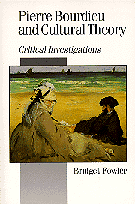

![]()
![]()

For scholars whose understanding and use of Bourdieu has been limited to social arenas like education, Fowler's focus on art and culture helps illuminate the extensive sociological utility in Bourdieu's culturalism. He contends people are not structurally constrained by predetermined life scripts, but are individuals who make decisions driven by rules as well as creative improvisation. This transcending of structuralism has led Bourdieu to focus on games and strategy through his immensely fertile concept of practice. Bourdieu's practice is a social order of rules mediated by "feeling" where individuals respond to social imperatives, not mechanistically, but more on the order of an experienced jazz musician or athletic player. These artists have a feel for their craft such that in the moment of action, they will improvise a compelling melody or make the right moves. This conceptualization of practice avoids a dichotomous standpoint of necessity versus choice, and instead, blends rules and improvisation realistically.
As Fowler notes, Bourdieu made artists' action the model for all normal skilled practices accomplished in everyday life. Although we found Fowler's rendering of practice to be quite informative, her rendering of habitus, which is the generator of practice, was reductionistic. The central role of habitus is in defining and limiting what is seen by an actor and how it is interpreted. In times of relatively rapid social change, the transposable nature of habitus will allow it to be constructed anew in each generation. Moreover, Fowler neither criticizes nor remediates Bourdieu's underdeveloped explanation of the dynamics of individual and structure interaction. For example, Fowler notes that members of the same social class share a habitus and that any improvisation would typically occur within this habitus. She also describes how within the habitus of artists, writers, and academics, there are practice differences stemming from individuals' social origins. Fowler acknowledges Bourdieu does not pay close enough attention to artists' motives and subjective meanings. However, Bourdieu and Fowler only hint at how other cultural (not social class) groups, such as artists, writers, and academics develop their own habitus. For example, she does not explore how the beginning artist develops an artist's habitus or comes to these practice understandings and learns to solve difficult technical practice issues.
Fowler provides a hermeneutic interpretation of Bourdieu's theories of culture and argues that he has rescued cultural production from simplistic social theory and its views of the artist in reductive and passive terms. Fowler argues that Bourdieu's cultural theory draws compelling connections between culture, capitalist production, and consumption and she speaks specifically to Bourdieu's notion that the modernist artist exists separately from the popular marketplace. In the cultural sphere of writing, Bourdieu believes that "the real writer establishes his reputation only through risking rejection and experiencing suffering" and that true artistic merit can not come from the populist ranks, because the popular artist can not produce work which looks at life insightfully. Fowler uses the examples of Zola and Rousseau, critically accepted and popular artists, to criticize Bourdieu on this point.
The art movement through the decades has undergone many changes which Bourdieu does not acknowledge as fully as Fowler would wish. One key change during the bohemian movement of the mid-1800s was that the academy no longer set the rules; critical works of art existed outside of the academy culture and the critic-dealer system took its place. Thus, art existed outside tradition.
Fowler takes issue with Bourdieu's not accepting that true art can be derived from populist work. She explains that for Bourdieu there is a difference between the "aesthetic gaze" and the "naive gaze." While the former looks at form and structure as a means of expression, the latter finds beauty in the commonplace. For Bourdieu, the culturally purer approach is the aesthetic which relies on an awareness of tradition, while the naive approach provides simple, mass entertainment. Though Bourdieu focuses on Manet's formalism, Fowler contends that Manet redirected the aesthetic gaze to the working class, which diverged sharply with the academy rules. In fact, views of working class subjects and entertainment were common for Impressionists; canvases depicted tranquil rural scenes, but now factories loomed in the background. In these paintings, the workers' world is never far away. New artist foci included new types of leisure; parks, ballets, cafes, and concerts. Fowler criticizes Bourdieu for his limited view of this period.
Fowler makes a strong case about Bourdieu's inadequate discussion of women in the arts. During the Impressionist period, the artist point of view was male. Thus, class and family were not the only links to power in the field. Gender played an essential role as well. The artist witnessed the world of the working classes, however women were not permitted entrance to many of these places. Cafes, bars, and nightclubs could only be entered as a couple, and thus women were excluded from these popular venues. Without entree, women artists were limited in ways unlike their male counterparts These limitations are reflected in their subject matter, often depicting familial scenes. Though the weakening of the academy helped women; on the whole, women were viewed as inspirations not the inspired. Thus, Fowler is surprised that Bourdieu does not critically analyze gender dynamics in cultural capital and habitus, given that the women painters of the time were as financially secure as the men.
In this book, Fowler's discourse is aimed at scholars who have a firm grounding in Bourdieuian theory and/or art history and literature, but nonetheless provides an appealing introduction to less-initiated scholars. Pierre Bourdieu and Cultural Theory: Critical Investigations makes a major contribution to cultural analyses and theoretical studies and promises to enhance the discourse.
Patricia M. McDonough and Barbara Tobolowsky
University of California Los Angeles, USA